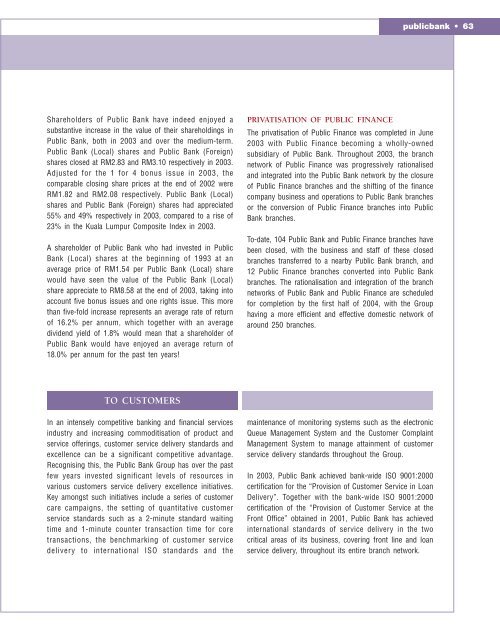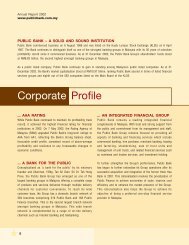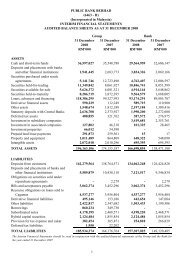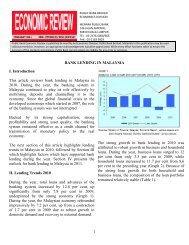Risk Management - Public Bank | PBeBank.com
Risk Management - Public Bank | PBeBank.com
Risk Management - Public Bank | PBeBank.com
- No tags were found...
You also want an ePaper? Increase the reach of your titles
YUMPU automatically turns print PDFs into web optimized ePapers that Google loves.
publicbank • 63<br />
Shareholders of <strong>Public</strong> <strong>Bank</strong> have indeed enjoyed a<br />
substantive increase in the value of their shareholdings in<br />
<strong>Public</strong> <strong>Bank</strong>, both in 2003 and over the medium-term.<br />
<strong>Public</strong> <strong>Bank</strong> (Local) shares and <strong>Public</strong> <strong>Bank</strong> (Foreign)<br />
shares closed at RM2.83 and RM3.10 respectively in 2003.<br />
Adjusted for the 1 for 4 bonus issue in 2003, the<br />
<strong>com</strong>parable closing share prices at the end of 2002 were<br />
RM1.82 and RM2.08 respectively. <strong>Public</strong> <strong>Bank</strong> (Local)<br />
shares and <strong>Public</strong> <strong>Bank</strong> (Foreign) shares had appreciated<br />
55% and 49% respectively in 2003, <strong>com</strong>pared to a rise of<br />
23% in the Kuala Lumpur Composite Index in 2003.<br />
A shareholder of <strong>Public</strong> <strong>Bank</strong> who had invested in <strong>Public</strong><br />
<strong>Bank</strong> (Local) shares at the beginning of 1993 at an<br />
average price of RM1.54 per <strong>Public</strong> <strong>Bank</strong> (Local) share<br />
would have seen the value of the <strong>Public</strong> <strong>Bank</strong> (Local)<br />
share appreciate to RM8.58 at the end of 2003, taking into<br />
account five bonus issues and one rights issue. This more<br />
than five-fold increase represents an average rate of return<br />
of 16.2% per annum, which together with an average<br />
dividend yield of 1.8% would mean that a shareholder of<br />
<strong>Public</strong> <strong>Bank</strong> would have enjoyed an average return of<br />
18.0% per annum for the past ten years!<br />
PRIVATISATION OF PUBLIC FINANCE<br />
The privatisation of <strong>Public</strong> Finance was <strong>com</strong>pleted in June<br />
2003 with <strong>Public</strong> Finance be<strong>com</strong>ing a wholly-owned<br />
subsidiary of <strong>Public</strong> <strong>Bank</strong>. Throughout 2003, the branch<br />
network of <strong>Public</strong> Finance was progressively rationalised<br />
and integrated into the <strong>Public</strong> <strong>Bank</strong> network by the closure<br />
of <strong>Public</strong> Finance branches and the shifting of the finance<br />
<strong>com</strong>pany business and operations to <strong>Public</strong> <strong>Bank</strong> branches<br />
or the conversion of <strong>Public</strong> Finance branches into <strong>Public</strong><br />
<strong>Bank</strong> branches.<br />
To-date, 104 <strong>Public</strong> <strong>Bank</strong> and <strong>Public</strong> Finance branches have<br />
been closed, with the business and staff of these closed<br />
branches transferred to a nearby <strong>Public</strong> <strong>Bank</strong> branch, and<br />
12 <strong>Public</strong> Finance branches converted into <strong>Public</strong> <strong>Bank</strong><br />
branches. The rationalisation and integration of the branch<br />
networks of <strong>Public</strong> <strong>Bank</strong> and <strong>Public</strong> Finance are scheduled<br />
for <strong>com</strong>pletion by the first half of 2004, with the Group<br />
having a more efficient and effective domestic network of<br />
around 250 branches.<br />
TO CUSTOMERS<br />
In an intensely <strong>com</strong>petitive banking and financial services<br />
industry and increasing <strong>com</strong>moditisation of product and<br />
service offerings, customer service delivery standards and<br />
excellence can be a significant <strong>com</strong>petitive advantage.<br />
Recognising this, the <strong>Public</strong> <strong>Bank</strong> Group has over the past<br />
few years invested significant levels of resources in<br />
various customers service delivery excellence initiatives.<br />
Key amongst such initiatives include a series of customer<br />
care campaigns, the setting of quantitative customer<br />
service standards such as a 2-minute standard waiting<br />
time and 1-minute counter transaction time for core<br />
transactions, the benchmarking of customer service<br />
delivery to international ISO standards and the<br />
maintenance of monitoring systems such as the electronic<br />
Queue <strong>Management</strong> System and the Customer Complaint<br />
<strong>Management</strong> System to manage attainment of customer<br />
service delivery standards throughout the Group.<br />
In 2003, <strong>Public</strong> <strong>Bank</strong> achieved bank-wide ISO 9001:2000<br />
certification for the “Provision of Customer Service in Loan<br />
Delivery”. Together with the bank-wide ISO 9001:2000<br />
certification of the “Provision of Customer Service at the<br />
Front Office” obtained in 2001, <strong>Public</strong> <strong>Bank</strong> has achieved<br />
international standards of service delivery in the two<br />
critical areas of its business, covering front line and loan<br />
service delivery, throughout its entire branch network.

















